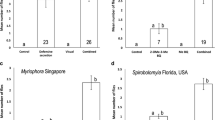Abstract
tert-Butyl 4- (and 5-) chloro-trans-2-methylcyclohexane-1-carboxylate (TML), a mixture of four majortrans and four minorcis isomers, is used as an attractant for detecting and monitoring the male Mediterranean fruit fly (medfly),Ceratitis capitata (Wiedemann). The eight isomers (racemic mixtures) were isolated by HPLC, and their relative attractiveness in the field was determined. A quantitative structure-activity relationship (QSAR) was proposed that related a molecular measurement (Å3) of the TML structure to male medfly captures. More recently, thetrans-TML enantiomers were synthesized in sufficient quantities for field testing. This paper reports the computer-aided molecular modeling, via Chem-X, of thetrans-TML enantiomers and the staggered and superimposed fitting with the most attractive isomer, (1S,2S,4R)-TML-C, to determine common volumes and surface areas from Van der Waals (VdW) maps. Observations of structure-activity relationships (SAR) are reported for the staggered fittings.
Similar content being viewed by others
References
Beroza, M., andSarmiento, R. 1964. Gas chromatographic analysis of insect attractants: Trimedlure, medlure, siglure, butyl sorbate, cue-lure, methyleugenol.J. Assoc. Off. Agr. Chem. 47:838–841.
Beroza, M., Green, N., Gertler, S.I., Steiner, L.F., andMiyashita, D.M. 1961. New attractants for the Mediterranean fruit fly.J. Agric. Food Chem. 9:361–365.
Burkert, U. andAllinger, N.L. 1982. Molecular Mechanics, ACS Monograph 177, American Chemical Society, Washington, D.C. p. 339.
Clark, T. 1985. Computational Chemistry, A Practical Guide to Chemical Structure and Energy Calculations. John Wiley & Sons, New York. p. 332.
Doolittle, R.E., Cunningham, R.T., McGovern, T.P., andSonnet, P.E. 1991. Trimedlure enantiomers: Differences in attraction for Mediterranean fruit fly,Ceratitus capitata (Wied.) (Diptera: Tephritidae).J. Chem. Ecol. 17:475–484.
Dunn, W.J., III, Wold, S., Edlund, U., Hellberg, S., andGasteiger, J. 1984. Multivariate structure-activity relationships between data from a battery of biological tests and ensemble of structure descriptors: The PLS method.Quant. Struct. Act. Relat. 3:131–137.
Freund, J.E., andWalpole, R.E. 1980. Mathematical Statistics, 3rd ed. Prentice-Hall, Englewood Cliffs, New Jersey. p. 419.
Hagen, K.S., Allen, W.W., andTassan, R.L. 1981. Mediterranean fruit fly: The worst may be yet to come.Calif. Agric. 35:5–7.
Hansch, C. 1991. New perspectives in QSAR.Pharacochem. Libr. 16:3–10.
Hayslett, H.T., Jr., 1968. Statistics Made Simple. Doubleday & Company, Garden City, New York. p. 107.
Jackson, D.S., andLee, B.B. 1985. Medfly in California 1980–1982.Bull. Entomol. Soc. Am. 31:29–37.
Kilpatrick, N. 1987. Business Statistics Using Lotus 1-2-3, John Wiley & Sons, New York. p. 259.
Leonhardt, B.A., McGovern, T.P., andPliummer, J.R. 1982. Capillary GC analysis of trimedlure, the attractant for the medfly.J. High Resolut. Chromatogr. Chromatogr. Commun. 5:430–431.
McGovern, T.P., andBeroza, M. 1966. Structure of the four isomers of the insect attractant trimedlure.J. Org. Chem. 31:1472–1477.
McGovern, T.P., Beroza, M., Ohinata, K., Miyashita, D., andSteiner, L.F. 1966. Volatility and attractiveness to the Mediterranean fruit fly of trimedlure and its isomers, and a comparison of its volatility with that of seven other insect attractants.J. Econ. Entomol. 59:1450–1455.
McGovern, T.P., Cunningham, R.T., andLeonhardt, B.A. 1986.cis-Trimedlure: Attraction for the Mediterranean fruit fly (Diptera: Tephritidae) and isomeric structural assignments.J. Econ. Entomol. 79:98–102.
McGovern, T.P., Cunningham, R.T., andLeonhardt, B.A. 1987. Attractiveness oftrans-trimedlure and its four isomers in field tests with the Mediterranean fruit fly (Diptera: Tephritidae).J. Econ. Entomol. 80:617–620.
McGovern, T.P., Warthen, J.D., Jr., andCunningham, R.T. 1990. Relative attraction of the Mediterranean fruit fly (Diptera: Tephritidae) to the eight isomers of trimedlure.J. Econ. Entomol. 83:1350–1354.
Sonnet, P.E., McGovern, T.P., andCunningham, R.T. 1984. Enantiomers of the biologically active components of the insect attractant trimedlure.J. Org. Chem. 49:4639–4643.
Topliss, J.G., andEdwards, R.P. 1979. Chance factors in studies of quantitative structure-activity relationships.J. Med. Chem. 22:1238–1244.
Warthen, J.D., Jr., andMcGovern, T.P. 1986. GC/FTIR analyses of trimedlure isomers and related esters.J. Chromatogr. Sci. 24:451–457.
Warthen, J.D., Jr., andMcGovern, T.P. 1988. Semi-preparative high-performance liquid chromatographic separation of trimedlure isomers.Chromatographia 25:811–814.
Warthen, J.D., Jr., Schmidt, W.F., Cunningham, R.T., DeMilo, A.B., andFritz, G.L. 1993. Quantitative structure-activity relationships (QSAR) of trimedlure isomers.J. Chem. Ecol. 19:1323–1335.
Author information
Authors and Affiliations
Rights and permissions
About this article
Cite this article
Warthen, J.D., Schmidt, W.F., Doolittle, R.E. et al. Structure-activity relationship observations oftrans-trimedlure enantiomers. J Chem Ecol 21, 69–79 (1995). https://doi.org/10.1007/BF02033663
Received:
Accepted:
Issue Date:
DOI: https://doi.org/10.1007/BF02033663




